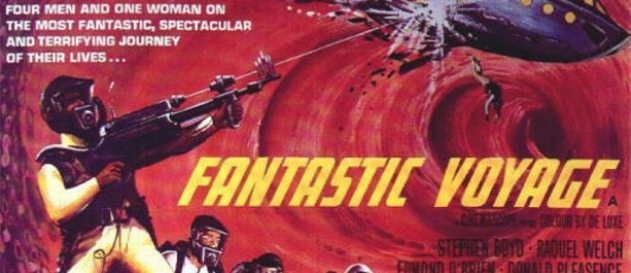
Fantastic Voyage was released in 1966, the same year that Gene Cernan completed the second spacewalk and Star Trek debuted on NBC. But the film eschewed the space race for a trip inside the human body.
Merely summarizing the plot does it no favors. A scientist working in the Soviet Union has discovered the secret of prolonged miniaturization (temporary miniaturization having already been perfected) and defects to the West. After being injured during an assassination attempt, the scientist slips into a coma caused by a blood clot. A team of five is set up with a submarine, shrunk down, and injected into the man’s arteries in order to destroy the blood clot with a laser. Needless to say, hijinks ensue.
The idea of sending people in tiny submarines shooting through someone’s coronaries asks for a heroic suspension of belief. And while the film won Oscars for Best Art Direction and Best Special Visual Effects, today the trippy backgrounds and unintentionally hilarious sets feel campy. But in an era before nanotechnology or neuroscience, the film presciently imagined a day in which people would be able to peer into the darkest recesses of the human body.
Neuroscientist and neuroethicist Dr. James Giordano, chief of the Neuroethics Studies Program at the Pellegrino Center for Clinical Bioethics at Georgetown University Medical Center, was seven years old when he saw the film for the first time, sparking a lifelong love of the brain that led him to devote his life to neuroscience. His career, he says, “literally was catalyzed by a roll of celluloid fifty years ago.”
Below are edited excerpts from a conversation with Dr. Giordano.
SSF: You’ve said Fantastic Voyage inspired you. It’s such a cool movie but it seems so improbable, scientifically.
JG: Yeah, but—but—think about when it came out, 1966…
I was born in 1959. We hadn’t gone to space yet. Very soon after I was born we had the whole Sputnik crisis, which really initiated the space race in earnest. So one of the earliest memories I have is sitting in front of my parents’ black and white television set watching the Mercury capsule take off. And I thought that was the coolest thing since sliced bread. I had grown up on science fiction because of all of the wonderful, albeit somewhat cheesy science fiction movies of the late 1950s we would watch on TV. On Science Fiction Theater, Chiller Theater, and every Saturday morning on WPIX or WNEW—channels eleven and five, respectively—they had science fiction stuff.
This was the age of discovery. We were pushing the boundaries. We were going to outer space and to deep inner space. This is the time when we were exploring the ocean bottom: There was the bathyscaphe and the Trieste deep submersible submarine. I was fascinated by all this stuff, truly.
So I’m seven years old. I’m in second grade. My father takes me to see this movie Fantastic Voyage. The movie blows me away for a number of reasons (not the least of which [is] Raquel Welch in a scuba suit). It’s everything I love. It’s a submarine, it has to do with miniaturization and they’re going to be injected into a body. It wasn’t like they were going to outer space or deep inner space like the bottom of the ocean, they were going inside the body. And I thought to myself: that’s what I want to explore. I remember actually saying to my father, I want to do that. And so he turns to me and asks, what do you want to do? And I said, I want to do that—I want to explore the brain. And I will never forget this until the day I die. He said, you know if you really want to do that, I think you probably could.
There’s a great line in this movie. They get to the point where they actually enter the brain in this little miniaturized submarine. For the first time they actually see neurological impulses sparking, so to speak, over nerve cells. Now, it was done with all the sophistication that was available in 1966, both scientifically in terms of what they knew, and of course, cinematographically in terms of what they could do. But it was still brilliantly done. Edmond O’Brien kind of waxes sentimental in this wonderful soliloquy, and he says that all of our aspirations, hopes, and histories, and all of our future is encapsulated in this single organ, in the sparks of thought that we see before us. And I thought, that’s the most cool thing in the world to explore because you’d never stop exploring.

I couldn’t stop talking about this movie. All of a sudden I’m telling my Dad I want to get books about the brain. This is in the middle of the 1960s; there was no neuroscience; there was no field that was titularly called neuroscience. But this was sufficient enough to capture not only my interest, but my imagination. What could one do with this? How could you combine those kinds of deep, profound thoughts of everything that humanity is and everything humanity could be, and use this cutting edge technology to do it? It became a lifelong love.
The field of neuroscience, as a titular field, as a defined field, really didn’t birth until the middle 1970s. There were a lot of intra-disciplines—there was pharmacology and anatomy and biology and chemistry—that were looking at functions and structures of the brain, and of course psychology, but they really hadn’t coalesced. In other words, there were all of the ingredients were in the pot but it wasn’t called stew until the end of the 1970s.
I was at that point just graduating from high school. I go off to college and my particular college had an academic major in physiological psychology and brain functions. And I was hooked. I mean the only things—truly the only things—that captivated my interest more than that were sports and girls. Sometimes the order was actually mixed up.
So I got to study this stuff and work in a laboratory. By the time I graduated from college in 1980, the field had come of age a bit. At that point there were still only four programs that were defined as neuroscience programs. I applied to all of them; I didn’t get in. But irrespective of that, by the time I was ready to go to graduate school, now these programs are really beginning to blossom. Even programs in biological and physiological psychology were emphasizing neuroscience. I was very, very fortunate. I went to City University of New York, that’s where I did my Ph.D.
Critically important to me was the fact that through every step of that, my north star was that when I was a seven-year-old kid there was this thing that seemed to concatenate all of my interests. It brought together my imagination, my creativity and my intellect. And it was a movie. That blows me away.
I think science fiction functions, in a way, in modern society how literature and myth functioned in classical and antiquarian society. There’s a Greek word that is called eidola; it means providing an ideal. So what it does is it provides this ideal that can communicate public aspirations, hopes, anxieties, fears. We understand it’s fiction, that the topic may be fiction, the extent may be fictional, but what isn’t fictional is its depiction of those things that are either liminal or subliminal fears in individuals, groups, communities, all of us.
SSF: Is there any part of the technology in the movie that you see being used now? It sounds like there’s actually an incredible parallel to your experience.
JG: So falling in love with this fifty years ago, have you seen it realized? Well yeah, in a couple of different areas. You have to back out from the way it was depicted a little bit. I mean we haven’t been able to miniaturize people and put them in submarines and inject the submarines in. But we’ve been able to miniaturize sensors and probes, so that instead of putting people in we can put a camera in that allows people to go inside the body. So the concept is there, although its conceptualization is a little bit different. The idea of being able to put miniaturized people into a brain and utilize a cold laser to dissolve away a blood clot that was interfering with brain function that was not accessible through standard surgical means? That’s become the laser knife, the gamma knife. We’re doing that. Now of course, we’re not doing it with little miniaturized people, but the idea of being able to use, for example, insertable probes, or robotically-guided gamma knives, to then engage in very, very complicated neurosurgery that would otherwise be inoperable? We’re there.

Fantastic Voyage did that. Of course, as you recall from the movie, [the technology] was used on an individual who had very particular secrets that were necessary for international security. To me, it’s ironic that here I am, at 55, and I’m doing work with DARPA [Defense Advanced Research Projects Agency], and my latest book deals with neurotechnology and national security.
This was 1966, and what they were really playing with was the idea of a government agency that was involved in secret projects that utilized cutting-edge science that could be used for public defense or for military operations. It was really an insight into the then very, very nascent DARPA. Also, you are dealing with miniaturization, and working on a scale so small that physical properties were alterable and changeable. So this was almost foresight to the field of nanotechnology, which didn’t bloom for another thirty years, twenty-five years.
And, then there’s the idea of probing the brain, utilizing the brain as a viable target, with a device that was essentially a submersible. Although it was manned in the movie, [it] is very much the type of thing we’re doing now, with a very, very high nanoscale drone apperati, which we can then insert into the bloodstream to travel around the body to do things like eradicate clots and take photographs and do a variety of bio-sensor scanning. In 1966, this was a movie with great foresight.
SSF: Have you seen or do you want to see anything more recent that had an interesting take or particularly accurate portrayal of the scientific community?
JG: If I were king for a day, I would go to one of the leading producers, one of the leading directors, and I’d say, listen, you have to remake Fantastic Voyage. You just have to. It’s so timely right now. The plot could be that there’s a foreign dignitary who’s not necessarily friendly to this country, they incur an injury, and so the only way to be able to avert an international incident that could be cataclysmic is to get this international team of scientists to do this through cooperative technology. That’d be great. And of course, you know all the computer graphics today and the all the wonderful CG effects would be killer. I mean, 3-D, you’re inside somebody’s brain—how cool is that?
SSF: What is interesting in science fiction now that in fifty years could an inspiration to your kids?
JG: We’re moving into this next era that’s going to be very much centered upon the brain sciences integrated with the computer sciences integrated with genetics: this is what we call convergent bioscience. It would be very cool to see some movies harnessing that. There’s great power in things that deal with the essence of what it means to be; whether what it means to be human, to be animal, to cross those bridges, what it means to be a sentient machines, and what that would incur. And there’s been some good ones: obviously Blade Runner, and even a movie like I, Robot did a nice job. Planet of the Apes did a wonderful job about crossing ontological boundaries between species.
I would say that that trend [is] very important in communicating the profound hope that the brain sciences, working together with the other sciences, are able to probe the depths of what it means to be human, and as a result build these bridges between people and other species and create some moral commonality and goodness.

SSF; Voyage is all about going into the body in a literal way. What you’re describing is the next step beyond, going into the immaterial brain—the mind.
JG: The idea that there’s something that can realistically get to the point where science is able to effectively probe the interface between the physical substrate brain and the thing that it does, which is to create consciousness, and then engage that interface somehow—that’s where the science fiction comes in, the fictional aspect, because we’re not there yet. We don’t understand how that happens, first of all, and we certainly don’t have a device to do it. That would be very cool.
SSF: By the way, I’m completely sold on a remake.
JG: You know the Faustian bargain? I’m not saying I’d go as far as to sell my soul, but if in fact somebody like Ridley Scott or James Cameron or another director or producer of that magnitude decided to engage with Fantastic Voyage with great C.G., I’d hack off a limb to be a scientific advisor on something like that. I’d think, “My life’s come full circle. This is great.”
TOPICS